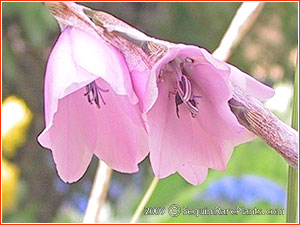 Dierama pulcherrimum Dierama pulcherrimum
- common names: wandflower; fairy's or angels' fishing rod; pulcherrimum means “the most beautiful”
- flowering season: summer
- height: 4 to 5 feet
- Light requirements: sun
- Soil requirements: deep and rich soil; moist but well drained
- Water requirments: average to moist
- Growth habit: grows into a thick clump with age
- How to propagate: either seeds or by dividing a plant
- Leaf type: thin, long and grass-like; evergreen in mild climates
- Ways to use it: its dangling flowers are exceptionally nice next to a pond; grows well in a mixed flower bed with other perennials
- Special characteristics: with age the roots develop large corm-like roots that will be about eight inches below the soil's surface; by the end of summer the plant will be dropping many seeds that will sprout the following year -- in a mild climate such as parts of California the seedlings can be weedy
- Other points of interests: no other plant quite resembles a Dierama -- it has many unique qualities
This wandflower is grown from seeds and has pale pink to lavender flowers. Its mature height is four to five feet. A taller dierama such as this will dance gaily in a breeze, just as though it were a fairy's fishing rod with a wee fish pulling on its line. USDA Zones 7 - 11. “Fairy's or Angels' fishing rods” cannot survive very much winter cold. This is a plant you will hardly ever see in Chicago or Boston! To grow it there, you would have to carry it over winter in a pot. When not in flower it looks very much like an ornamental grass, and would make a good centerpiece to a medium to large sized container garden, ... but only if you want something out of the ordinary. |
|

 Dierama pulcherrimum
Dierama pulcherrimum